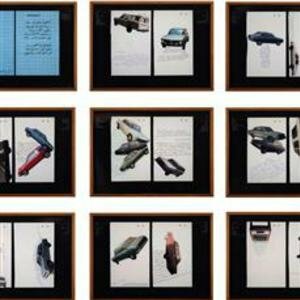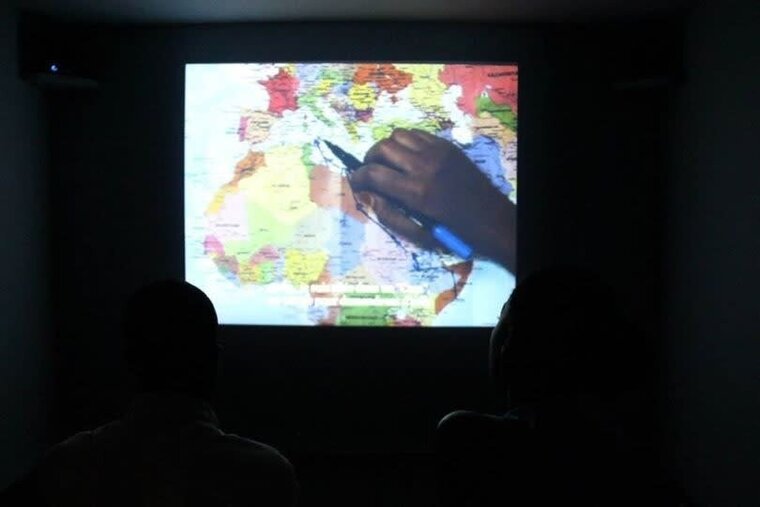


Last updated on Fri 14 June, 2013


MÉCANIQUES DES FLUIDES (NAVIGUER, TRANSPORTER, FILMER): EXPOSITION COLLECTIVE
14 JUNE - 27 JULY 2013
ABIDJAN
The films and videos featured in this exhibition deal with situations related to the marine world –they open spaces of floating and movement. Water and its environment can figure as an idyllic background or an abysmal strength. As a means of survival, transportation and exploration, water sometimes holds the promise of freedom, of a border to cross. However oceans, harbors, rivers are also places for loss and oblivion. Contemporary phenomena – the migrations of exile, the fantasy of a unified and accessible world that gave birth to globalization – browse at the surface of the seas. These films are about the hope for a better life and longing for exoticism, the dreams of prosperity and its counterpart the economic risk, the shipwrecks, the fascination for the abyssal depths and some modern forms of odysseys.
The movement of the images will allow the viewer to navigate between the different landscapes and narrative forms. These images describe a horizon for exchanges and trade, which is also that of a large supply of imagination and human resistance.
Mécaniques des fluides: a journey
« Growing up in a harbor predisposes one to retain quaint ideas about matter and thought (…) Ships explode, leak, sink, collide. Accidents happen everyday. Gravity is recognized as a force. By contrast airline companies encourage the omnipotence of thought. This is the reason why the commissioner of airports for the city of Los Angeles is paid much more that the commissioner of harbors. The airport commissioner has to think very hard, day and night, to keep all the planes in the air. » Allan Sekula.
The exhibition Mécaniques des fluides starts with an image that plays in a loop, the one of the departure at sea of a fishing boat. The men fight off the strength of the waves that repels them endlessly. Fishermen (études, n°1), Eija Liisa Ahtila, 2007, is a very brief documentary produced in Benin, drafted as a preparatory sketch.
The loopgives this daily incident a Sisyphean resonance and sets the tone for an exhibition dedicated to our relationship with the most important part of the surface of the globe, the sea world, which goes through Africa, Europe, America, the North Pole and China.
It is the very first time that Cecile Fakhoury Gallery presents an exhibition entirely devoted to film and video in Abidjan.
Screens have invaded the space, and artistic environments very different from each other immerse us in stories of contemporary lives. We come across different places of projections that alternate between fast pace sequences and others that are more meditative. We go from a tale of trades between Europe and Africa (Francis Alÿs) to a parable of the horizon (The Atlas Group), to astounding ‘‘re-reading’’ of the maps of the Mediterranean world (Bouchra Khalili).
Exploratory projects (John Akomfrah, Pierre Huyghe, Zhou Tao) stand along a radical investigation of the use of the sea (Allan Sekula), and a strange apology of the coastal lifestyle(Neil Beloufa). All these films connect the documentary approach and the poetic narration style.
Starting from the common ground that is the marine world, Mécaniques des fluides creates different reflections on what happens there, usually far away from our sight. The selected films deal with boats, coasts, and harbors, as well as mythology and stereotypes on travels, the fantasy of the horizon, the politics of the economy and the human exploitation at sea.
A cinema is a place where we can dream in the dark, identify, project, and allow ourselves to be carried away towards places that are usually inaccessible. It presents us with an access to utopia: an ideal that does not exist and arouses our desire. An achieved utopia is what the philosopher Michel Foucault referred to as ‘’heterotopia’’ giving the example of the boat ‘‘a floating section of space, a place without place, that exist by itself and at the same time is given over to the infinity of the sea’’. The boat is a hybrid and prodigious place, a closed space that is self sufficient but also attached to a multitude of places, a figure that hosts our imagination and presents it with a materiality by multiplying the connections to a tangible world. The cinema projection screen is also a floating space, a stable and trivial object whereby we access thousands of experiences. During the length of Mécaniques des fluides, you will be able to embark to unknown destinations and be confronted with different ways to be present in the world, you will be able to experiment a cruising, both distant and internal, at your own scale and pace.
A video exhibition curated by Marie Muracciole
John Akomfrah, Mnemosyne, 45’, 2010.
Francis Alÿs, Don’t Cross the Bridge Before You Get to the River, 7’43’’, 2009.
Eija-Liisa Ahtila, Fishermen, (études, n°1), 5’34’’, 2007.
The Atlas Group, I Only Wish That I Could Weep [cat. FD]_Weep_Videotapes_001-006, 6’18’’, 2000.
Neil Beloufa, People’s passion, lifestyle, beautiful wine, gigantic glass towers, all surrounded by water, 11’, 2011.
Pierre Huyghe, A Journey that wasn’t, 21’41’’, 2006.
Bouchra Khalili, The Mapping Journey Project, 2008-2011, installation vidéo, 8 vidéos.
Allan Sekula, Lottery of the Sea, 180’, 2006.
Zhou Tao, After Reality, 13’08’’, 2012.
Join us in our endless discovery of modern and contemporary Arab art